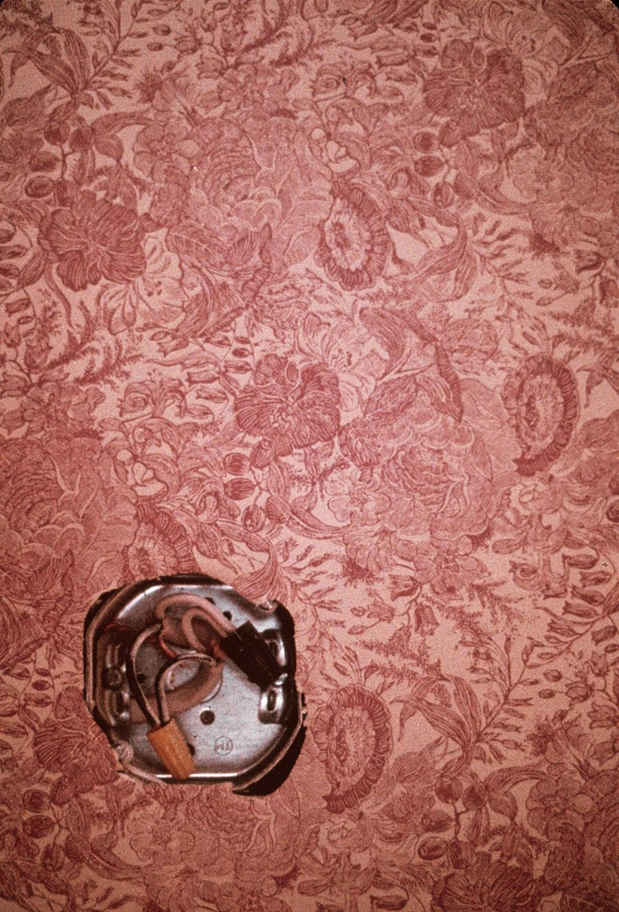Tim Maul “When Walls Become Pictures”
Leslie Tonkonow Artworks + Projects

[Image: Tim Maul "Norwalk" (1985) Type C print, 19-3/4 x 13-1/2 inches (framed)]
This event has ended.
Leslie Tonkonow presents a survey of photographic works by Tim Maul. The exhibition, including more than forty pieces made between 1974 and 2011, is our third solo presentation of the artist’s work.
Since 1973, when he graduated from the School of Visual Arts with a degree in painting, Tim Maul has produced deadpan, snapshot-style images that tease out the hidden meanings of “the things between the things we see,” transforming prosaic renderings into objects that combine intellect, irony, wit, pathos, and beauty.
An early challenger of accepted norms of artistic photography, his images appear to have been shot like tourist pictures – on impulse, usually in color using a hand-held camera when, in fact, each image is a thoroughly considered visualization of an idea or an emotional response to such subjects as a sheet of carbon paper, an audio cassette, an elevator bank, or a construction site.
In a 1992 interview with Leslie Tonkonow in the Journal of Contemporary Art, Maul says: “I plan each photograph fairly well. I usually see it first, write down the fact that I saw it, and go back and photograph it later.” He has habitually photographed the hotel rooms he has stayed in and, for many years, has privately documented family visits to his childhood home.
A mild fascination with the occult has been an ongoing preoccupation for the artist. In the early 1990s he photographed “haunted” sites pointed out by a psychic who accompanied him on a tour of Lower Manhattan. The resulting series,Traces and Presence, was exhibited at the International Center of Photography in New York and at the Centre Pompidou, Paris which acquired the entire group of fifty-seven black and white Cibachrome prints. The artist also documented other allegedly haunted locations in photographs taken during many annual visits to Strokestown Park, an eighteenth-century manor house in County Roscommon, Ireland.
Tim Maul arrived in New York in 1969 to attend the School of Visual Arts and completed his studies in 1973, a pivotal moment that he describes as “a good time to be a cultural sponge.” Describing his decision to stop painting in favor of the camera, he writes:
I was drawn to the media around conceptual and narrative art, Arte Povera, and to residual images generated by performance, land, and ‘body’ artists. Photography here had a job to do and was in Duchampian terms ‘in service’ to an idea. Photographs were ‘made’ instead of ‘taken.’ I bought a cheap camera and frugally produced apartment- based projects. By the decade’s end, the meteoric rise of the handmade art object disrupted, perhaps for good, the trajectory of a certain kind of reductive logic in regard to art’s historic progression. I loved the sequential but began to take single images and although ‘fine art’ and ‘street’ photographers never held my interest I respected them.
I valued the habitual over the spontaneous, the removed over the engaged, and embraced the touristic, even in my own environment. I believe the painter’s studio is a stage for the performative behavior necessary to produce certain kinds of paintings and I adopted role-play to a mild degree in accepting the permissions granted to the camera-toting individual: industrial spy one day; sensitive poet, the next.
Throughout the 1980s and 1990s, when artists used photography to create increasingly large and often monumentally-sized works, Tim Maul chose to present his images on a modest scale in keeping with the intimacy of looking closely at the everyday things that one normally dismisses or sees only at the edges of attention. His pictures are presented as unique objects – sometimes mounted on box-like panels or traditionally framed and matted.
Highlights of the exhibition include the series Color Photographs for Home and Office (1986), small framed pictures described in Artforum by the late critic Jean Fisher as “made directly from common surroundings whose familiarity gives rise to uncanny effects.”
Also exhibited are enlarged images from Traces and Presence, views of hotel rooms in Paris, London, Boston, and Brussels, and photographs of books. The largest work in the exhibition, a triptych entitled A Terrible Beauty, pays homage to the conflicted history of Ireland, (where Maul has worked and exhibited for many years) via photographs of the eponymous book by Jill and Leon Uris. In a diptych entitled The Devil’s Half-Acre, a demonic presence is visible in a photograph of the swirling waters of Lough Key in County Roscommon, Ireland “where numerous people had been purposely drowned during the Irish War for Independence.”
Born in 1951 in Stamford, Connecticut, Tim Maul’s artistic career has included performances at museums and alternative spaces including PS 1; White Columns; Franklin Furnace; the ICA, Boston; the Temple Bar Gallery, Dublin; and many other well-known venues. He has written regularly on the works of other artists for publications such as Art in America and Afterimage.
Photographs by the artist have been exhibited at galleries and museums throughout the U.S. and Europe, including The Metropolitan Museum of Art, New York; the Centre Pompidou, Paris; The Photographers Gallery, London; the International Center of Photography, New York; The Contemporary Arts Center, Cincinnati; the Smithsonian American Art Museum, Washington, DC; the Berkeley Art Museum; the Orchard Gallery, Derry, Ireland; Artists Space, New York; and many other distinguished institutions.
Works by Tim Maul are in the collections of The Metropolitan Museum of Art, New York; Centre Georges Pompidou, Paris; the Berkeley Art Museum and Pacific Film Archive, Berkeley; the Centre national des arts plastiques, Paris; and the Smith College Museum of Art, Northampton, MA.
Media
Schedule
from May 31, 2018 to July 27, 2018
Summer Hours: Monday–Friday, 10am to 6pm. Closed July 3–4.
Opening Reception on 2018-05-31 from 18:00 to 20:00